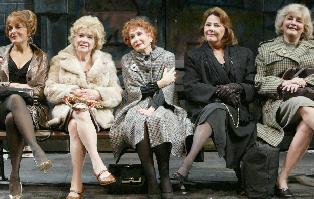SEARCH CurtainUp
REVIEWS
FEATURES
NEWS
Etcetera and
Short Term Listings
LISTINGS
Broadway
Off-Broadway
BOOKS and CDs
OTHER PLACES
Berkshires
London
LA/San Diego
DC
Philadelphia
Elsewhere
QUOTES
On TKTS
LETTERS TO EDITOR
FILM
LINKS
MISCELANEOUS
Free Updates
Masthead
NYC Weather
The Oldest Profession
|
This is America where any girl can start in an alley and become a madam. ---Mae, who has followed the path she describes but, finds Reaganomics weakening her hold on her little "stable" of over the hill practioners of The Oldest Profession. |

Patricia Lopez, Mary Louise Burke, Patricia Helmond, Carlin Glynn & Joyce Van Patten (Photo Carol Rosegg)
|
Vogel describes The Oldest Profession as her only pattern play. This means a structure which moves a story forward through variations on a particular situation or experience -- we have six scenes, each beginning on the park bench and updating us on the five shady ladies' situation. Their enterprise not only continues to lose customers, but its own members. And so, the five "blackbirds" become four, then three, then two until only one is left, and the park bench scene openings are book-ended with a song from the last departed in a facsimile of the New Orleans bordello where all five got their start.
This patterning structure has built-in risks. It can become too repetitive to hold an audience. The jokes that at first make light of the women's not so funny economic desperation risk comparison to sitcom humor. The quirks used to individualize the women tend towards shtik. But with David Esbjornson to conduct the scene and mood shifts on Narelle Sissons' turntable set, predictability is kept in check. Best of all, Vogel's representatives from the oldest profession are played by five thoroughly professional actresses who manage to be funny (well, more often than not) and emerge as real people who tug at our heartstrings.
We meet Madame Mae and her "girls" for the first time a week before the Reagan election. E With a helping hand from Elizabeth Hope Clancy's well chosen costumes, each actress immediately and firmly establishes her persona. Katherine Helmond, in a checked cape suit and pillbox hat, is the very model of the chief operating officer or madam, whose comic in-charge stance poignantly disintegrates as she realizes that her memory is slipping away. Joyce Van Patten's Ursula, who champions Reaganomics, gets the most zingers. Like many a current business news headliner, her move from worker to management does not beckon well for the group's finances. Carlin Glynn is Lillian, the bench beauty queen, an apt choice given her history as the Tony-award winning Miss Mona in The Best Little Whorehouse in Texas. Though Edna would probably be at least fifteen years older than Priscilla Lopez, Ms. Lopez is so good that one is as willing to suspend belief about her age as about some of the plot's details. When these women leave the The Life as lived in the grungy '80s New York and re-emerge as sexily clad ghosts of their youthful New Orleans selves, their singing and cavorting around the Storyville bordello "heaven " could easily be embarassing to watch -- but not with Helmond, Van Patten, Glynn and Lopez to handle these musical scenes.
While Mary Louise Burke's Vera is the only one who doesn't get to sing one of the nifty Storyville jazz numbers (e.g. "I'm No Angel" and I"f I can't Sell It, I'll Keep Sitting On It"), hers is the at once funniest and saddest portrayal. Besides being Vogel's stand-in for her beloved Grandmother, Vera, especially as played by the consistently superb Burke, is this play's version of Winnie from Beckett's Happy Days.
The Oldest Profession may not be as polished as the Pulitzer Prize winning How I Learned to Drive, but like that and all Paula Vogel's plays, it demonstrates her ability to overlay painful experience with humor. It is a fitting prelude to the other plays scheduled for this as always valuable retrospective-- The Baltimore Waltz, to be directed by Mark Brokaw and Hot 'N' Throbbing, a New York premiere to be directed by Les Waters.
| THE OLDEST PROFESSION
Written by Paula Vogel Directed by David Esbjornson Assistant Director: Antonia Grilikhes-Lasky Cast: Marylouise Burke (Vera), Joyce Van Patten (Ursula), Carlin Glynn (Lillian), Katherine Helmond (Mae) and Priscilla Lopez (Edna). Music Director/Pianist: Bernard Corbett Set Design: Narelle Sissons Costume Design: Elizabeth Hope Clancy Lighting Design: James Vermeulen Sound Design: Darron L. West Hair & Wig Design: Marty Kopulsky Choreographer: Lisa Shriver Running time: 1 hour and 40 minutes, without an intermission Signature Theatre Company, Peter Norton Space, 555 W. 42nd Street,www.signaturetheatre.org, 212/ 244-7529 Tuesday through Saturday evenings at 8pm, with matinees on Saturday and Sundays at 3pm. From 8/17/04 to 10/10/04; opening 9/26/04. Reviewed by Elyse Sommer based on 9/26 press performance |

Retold by Tina Packer of Shakespeare & Co.
Click image to buy.
Our Review

Mendes at the Donmar
Our Review

At This Theater

Leonard Maltin's 2003 Movie and Video Guide

Ridiculous!The Theatrical Life & Times of Charles Ludlam

6, 500 Comparative Phrases including 800 Shakespearean Metaphors by CurtainUp's editor.
Click image to buy.
Go here for details and larger image.



